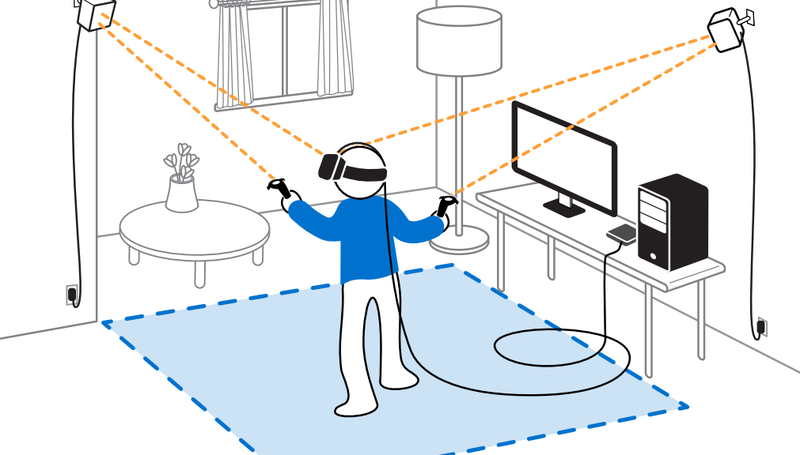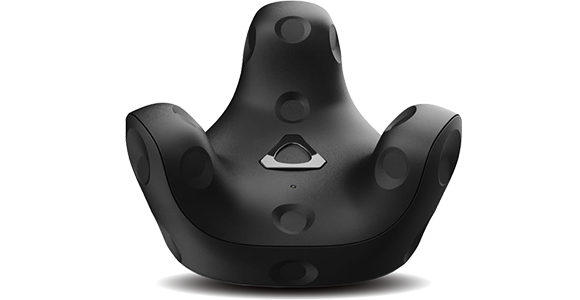VR Full Body Tracking Guide: Advantages and disadvantages of tracking technologies
by Audrey Pompagnini on Feb 02, 2024
Virtual Reality has transformed the way we experience digital worlds, offering immersive environments that go beyond visual and auditory sensations. One of the key aspects of this enhanced immersion is full-body tracking, which enables users to reproduce their real-life movements in the virtual world. In this article, we'll explore the advantages and disadvantages of the different tracking technologies used for full-body tracking in VR.
Base station tracking technology
Base station tracking technology, exemplified by systems such as SteamVR and base stations 2.0 (Lighthouse), offers high accuracy and stability. These systems act by scanning space with fixed lasers to precisely locate trackers and VR headsets in all postures and actions.
Benefits :
- High precision: Ideal for professional-level applications and detailed motion capture.
- High stability: Guarantees precise tracking even during complex movements.
Disadvantages:
- Complicated installation: Setting up base stations can be tedious, and requires consideration of space and potential light reflection issues.
- Reduced mobility: Moving the VR system to another room means repeating the installation process.

IMU technology
Inertial Measurement Unit (IMU) technology offers a lightweight, portable alternative to base station tracking. Devices such as Sony's Mocopi tracker use IMUs, which include three-axis gyroscopes and accelerometers to measure relative movements.
Advantages :
- Portability and lightness: Easy to use without a base station.
- Lower cost: More affordable for the general public.
Disadvantages:
- Less precision: Tracking relative movements can lead to drift and latency over time.
- Sensitive to environmental magnetic fields: May be affected by magnetic interference.
Trackers with "inside out" tracking
Inside-out" tracking technology combines computer vision (CV) with IMU technology to provide precise tracking without base stations. The HTC VIVE Ultimate Tracker is an excellent example of this approach. It uses wide-angle cameras and AI technology to calculate precise absolute positions in real time.
Advantages :
- Portable and lightweight: No need for base stations.
- High accuracy: Offers precision without the errors associated with IMU-only tracking.
Disadvantages:
- Weaker occlusion resistance: May encounter tracking difficulties when objects obstruct the view.
- Requires adequate lighting: Adequate lighting is essential for optimum performance.
Popular VR trackers
VIVE VIVE Ultimate Tracker: Redefining VR tracking
A game-changer in the world of virtual reality, the VIVE Ultimate Tracker offers automatic tracking without the need for external devices or base stations. It seamlessly translates users' movements into immersive virtual and mixed reality experiences, enhancing interactivity.
![]()
Compatible with standalone HTC VIVE devices such as the VIVE XR Elite and VIVE Focus 3, and promising future support for OpenXR and SteamVR-based PC VR devices, it appeals to a broad user base.
Thanks to cutting-edge 6DoF inside-out technology and two wide-angle cameras, it accurately tracks objects in 3D space. In addition to tracking whole-body movements, it excels at tracking a variety of objects, thanks to its standard 1/4"-20 UNC threaded mount. HTC's publication of 3D CAD files enables users to customize the mount to their specific needs.
The VIVE Ultimate Tracker not only revolutionizes portable positional tracking, it also opens up new possibilities in the XR ecosystem. Ideal for those seeking realism and immersion, this innovative product is a game-changer worth exploring.
VIVE Tracker 3.0

Launching in 2021, HTC's VIVE Tracker 3.0 revolutionizes the VR experience. Powered by SteamVR tracking technology, it accurately tracks users and objects, supporting full-body and object tracking. Featuring an integrated battery and wireless module, it offers up to 7 hours of continuous use and can connect to a variety of accessories. Weighing in at just 75 grams and boasting longer battery life, it has been praised for its precision and versatility. The impact of this tracker extends beyond gaming, changing the game in the world of motion capture by offering an affordable, portable alternative to traditional systems.
Tundra Tracker: A game-changer in VR thanks to crowdsourcing
![]()
Developed by Tundra Labs, the Tundra Tracker saw the light of day in 2021 thanks to a successful crowdfunding campaign that exceeded its funding target. It aims to rival the HTC VIVE Tracker, offering high-performance tracking with a lighter, more affordable design, weighing less than 50 grams. With a competitive battery life of 7 hours, it's a match for its heavier counterpart. However, global component shortages have led to price adjustments, with the price of a set of three trackers now standing at $378. Despite these difficulties, the Tundra Tracker offers a lightweight alternative, meeting the demand for cost-effective VR tracking solutions.
SlimeVR: full-body tracking at an affordable price
![]()
Launched by crowdfunding in 2021, SlimeVR is an open-source, full-body VR tracking device based on IMU technology, eliminating the need for external devices or base stations. The basic kit includes five trackers placed on the thighs, ankles and chest, capturing lower-body movements. Although it doesn't reach the accuracy of the VIVE Tracker, users appreciate SlimeVR's affordability, compatibility and value, despite the occasional need for calibration. This cost-effective solution has gained popularity with those looking for reliable full-body tracking options.
Sony Mocopi: Empowering VTubers and creators

Sony Mocopi, designed for VTubers and content creators, offers wireless VR tracking. Users simply install a dedicated app and wear six lightweight trackers (8 grams) on body parts such as the head, wrists, ankles and hips, enabling full-body tracking. These trackers collect movement data via the app, facilitating video recording and customization of virtual characters. Although Mocopi's precision isn't up to the level of high-end devices, its affordable price makes it a top choice for novice creators and VTubers looking for basic motion capture solutions.
HaritoraX Wireless: IMU-based freedom

Launched in 2023 by Shiftall, the HaritoraX Wireless VR tracker offers a revolutionary experience. Weighing in at just 17 grams, it boasts an impressive battery life of 20 hours. The main improvement over its predecessor, the HaritoraX 1.1, is its total wireless capability, which offers unprecedented freedom, particularly for activities such as dancing.
The HaritoraX Wireless base kit supports 6-point tracking (chest, hips, knees, ankles) and allows users to extend tracking to 11 points with additional trackers. Its compatibility with popular VR applications such as VRChat and NeosVR makes it a top choice for VR enthusiasts. This IMU-based tracker offers unrivalled freedom and versatility in the world of virtual reality.
Conclusion
Choosing the right VR tracking technology and equipment depends on individual needs, budget and desired level of experience. Whether you're a professional, a content creator or a casual VR enthusiast, understanding the characteristics of different tracking technologies is essential to selecting the most appropriate equipment.
As technology advances, we can expect even more innovative tracking methods that will make VR experiences increasingly vivid and enjoyable. The world of whole-body tracking in VR is evolving rapidly, and there is no doubt that it will continue to push back the boundaries of what is possible in the virtual world.




